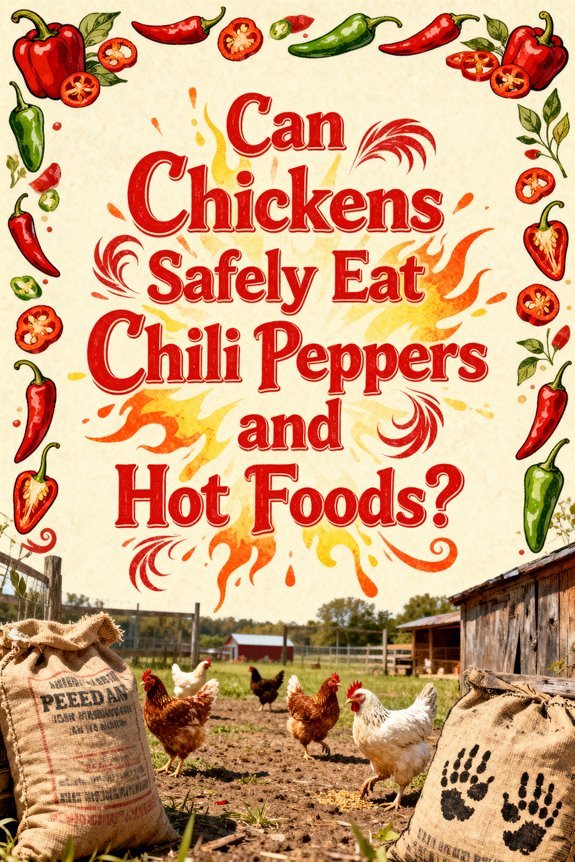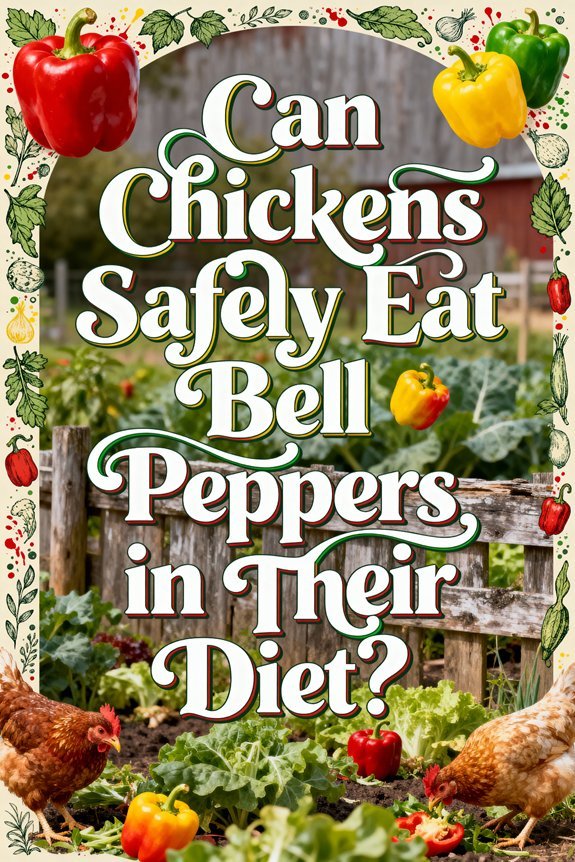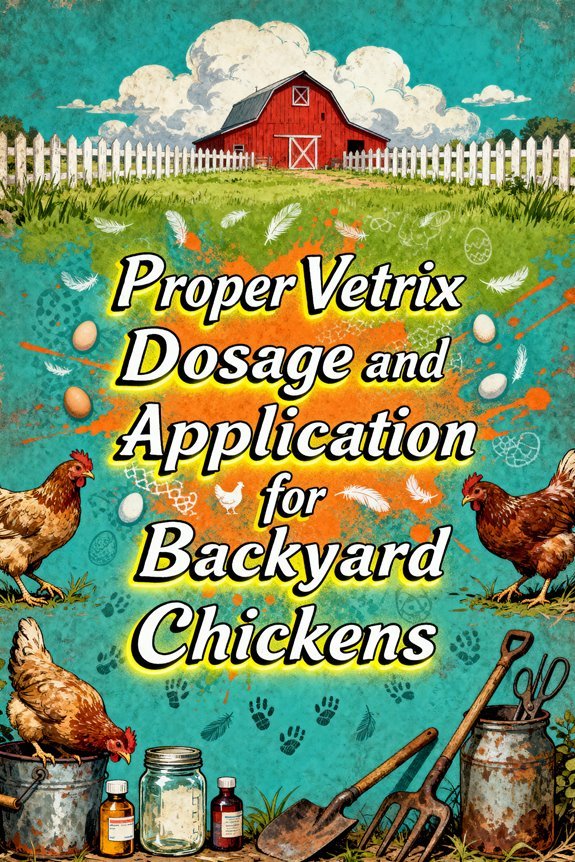Can Chickens Safely Eat Chili Peppers and Hot Foods?
Your chickens can safely consume hot peppers and spicy foods because they lack the TRPV1 receptor that makes mammals sensitive to capsaicin. Hot peppers offer health benefits for your flock, including improved bacterial resistance, enhanced immune response, and better digestive efficiency. While the ripe fruits are safe, you’ll need to prevent access to toxic parts like leaves and stems. Understanding proper preparation and monitoring techniques will help you maximize these nutritional advantages.
The Science Behind Chickens and Spicy Foods
While humans experience the fiery sensation of chili peppers through specialized receptors, chickens possess a remarkable physiological difference that makes them immune to capsaicin’s heat. This immunity stems from their unique taste receptor configuration, which lacks the TRPV1 receptor responsible for detecting spiciness.
You’ll find that chicken taste receptors are limited to detecting bitter, salty, and sour flavors, but they’re completely unresponsive to both sweet and spicy sensations. This evolutionary adaptation allows your chickens to safely consume hot peppers that would cause significant discomfort in humans. The birds’ spiciness perception, or rather lack thereof, isn’t limited to domestic chickens – it’s a trait shared across many wild bird species. This biological feature enables them to eat various hot peppers without experiencing any adverse reactions or pain. In fact, chickens that consume cayenne pepper often show improved bacterial resistance thanks to capsaicin’s ability to break down harmful bacteria.
Health Benefits of Hot Peppers for Your Flock
When considering nutritional supplements for your poultry, hot peppers emerge as a scientifically-validated addition that offers multiple physiological benefits for chickens. The capsaicin in hot peppers strengthens your flock’s immune response while combating harmful intestinal pathogens and parasites.
You’ll find that hot peppers enhance your chickens’ digestive efficiency through improved nutrient absorption and enzyme activity. The compounds in these peppers stimulate bile production, leading to better feed conversion rates and reduced costs. Similar to baked flock blocks, hot peppers can be incorporated into homemade treats for added nutrition. Adapting feed supplements like hot peppers during the pullet stage helps establish healthy eating habits. While they won’t greatly increase egg production, they’ll enrich yolk color through increased carotenoid levels.
Hot peppers contain higher calcium and iron than bell peppers, making them an excellent addition to your chickens’ diet. As a natural alternative to synthetic antibiotics, hot peppers provide a cost-effective way to maintain flock health. They’re particularly valuable in organic farming practices, offering antimicrobial protection without chemical residues.
Safe vs. Toxic Parts of Pepper Plants
Understanding the distinction between safe and toxic parts of pepper plants is essential for chicken keepers, as solanine toxicity poses a significant health risk to poultry. The toxic plant parts include leaves, stems, flowers, and unripe green fruits, which contain dangerous levels of solanine alkaloids that can cause severe illness or death in chickens.
In contrast, the edible pepper components are limited to ripe fruits, their seeds, and cores. These parts don’t contain harmful solanine levels and provide valuable nutrients, including carotenoids that enhance egg yolk color. While chickens can’t detect capsaicin’s heat, they’ll safely consume both sweet and hot pepper varieties. You’ll need to prevent your flock from accessing pepper plant foliage and guarantee you’re only offering fully ripened fruits as treats. High vitamin A content in ripe peppers supports optimal eye health and immune function in chickens.
Best Practices for Feeding Hot Peppers to Chickens
Before introducing hot peppers to your chickens’ diet, you’ll need to implement specific preparation and feeding protocols to guarantee safety and ideal nutrition. Start your pepper preparation by thoroughly washing the peppers to remove contaminants, then remove seeds and stems. You’ll want to chop the peppers into small, manageable pieces for easier consumption.
Just as electric poultry netting helps protect chickens from predators, proper feeding practices safeguard their health and wellbeing. When implementing feeding techniques, maintain strict moderation. Limit hot peppers to occasional treats comprising less than 10% of your flock’s total diet. Monitor your chickens for any adverse reactions when first introducing peppers. While cooking isn’t required, it may enhance digestibility. Always avoid moldy or rotten peppers, and don’t include harmful additives like salt or garlic during preparation. Use organic peppers when possible to minimize pesticide exposure. Your chickens won’t experience any discomfort since they cannot taste capsaicin like mammals do.
Myths and Facts About Chickens and Capsaicin
Many misconceptions exist about chickens’ relationship with spicy foods, particularly regarding capsaicin – the compound responsible for chili peppers’ heat. You’ll find that chickens possess a unique TRPV1 receptor variant that makes them naturally resistant to capsaicin’s burning sensation, unlike mammals. This biological difference means they don’t experience pain from spicy foods. Understanding chickens’ natural pain management solutions has inspired research into new approaches for human pain relief.
Research demonstrates that capsaicin isn’t toxic to chickens at typical dietary levels. In fact, controlled capsaicin supplementation can enhance growth performance and boost antioxidant responses, especially under stress conditions. When making dietary adjustments, you should note that chickens’ spicy preferences aren’t limited by discomfort – they’ll readily consume capsaicin-containing feeds. Studies show that appropriate capsaicin supplementation may improve feed efficiency and intestinal health without adverse effects.
Incorporating Hot Peppers Into Chicken Feed
When incorporating hot peppers into chicken feed, you’ll need to evaluate both the nutritional benefits and ideal delivery methods for maximum effectiveness. Since chickens lack VR1 receptors, they can safely consume hot peppers without experiencing the burning sensation humans feel. Start with moderate amounts of dried, ground hot pepper types like cayenne, chili, or jalapeno, mixing them thoroughly into regular feed mixtures at recommended ratios. You’ll want to source organic peppers when possible to avoid pesticide exposure.
Monitor your flock’s response as you gradually increase the proportion of peppers in their feed. While chickens can’t taste capsaicin’s heat, excessive amounts could potentially cause digestive irritation. Track feed consumption, egg production, and manure consistency to optimize dosage. During colder months, you might consider increasing hot pepper supplementation to boost immunity and provide warming effects.
Warning Signs and Safety Precautions
Monitoring your chickens for adverse reactions to capsaicin exposure requires vigilant observation of specific warning signs. Watch for behavioral symptoms including decreased feed intake, excessive water consumption, lethargy, and agitated pecking. Signs of gastrointestinal distress may include vomiting, diarrhea, and abdominal discomfort. Look for skin irritation, redness, or inflammation where direct contact with peppers occurred. Proper ventilation is essential when preparing hot peppers in areas where chickens may be present.
If you observe any concerning symptoms, take immediate action. Remove affected birds from pepper-containing feed sources and guarantee constant access to clean water. Use protective gloves when handling hot peppers to prevent accidental transfer. For eye exposure, rinse thoroughly with warm water. If birds show respiratory distress or severe reactions, isolate them and seek veterinary care promptly. Consider using diluted vinegar solutions to neutralize capsaicin on skin contact.



